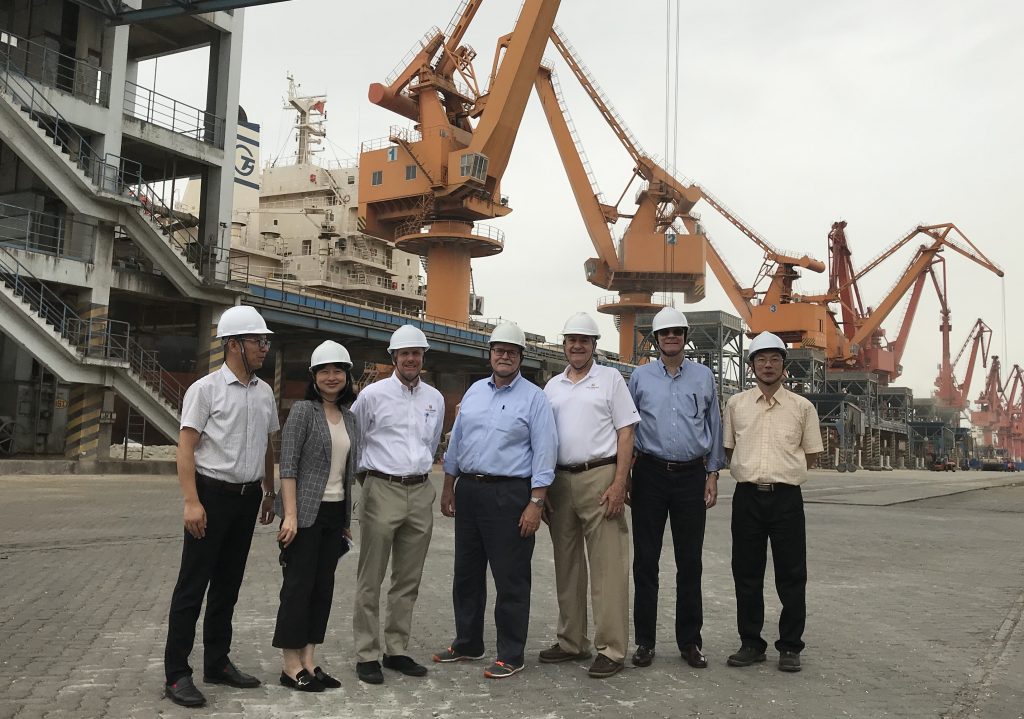A recent mission to China including the U.S. Grains Council’s (USGC’s) top member-leaders and staff concluded that while the Chinese market for U.S. grains and related products is consistently inconsistent, it holds tremendous potential.
“We have worked to build markets for nearly 60 years, believing that trade is vital to the prosperity of both our customers and our individual members, farmers and exporters,” said USGC Chairman Jim Stitzlein, who led the outreach this month. “Ultimately, our customers in China want the same end-goal as our members – steady, stable trade policy.”
Stitzlein joined USGC Vice Chairman Darren Armstrong and USGC President and Chief Executive Officer Tom Sleight in meeting with the Council’s staff in China as well as with key USGC partners, contacts and government officials. While official trade talks between the Chinese and U.S. governments appear stalled for the time being, feed, livestock and grain trading contacts hope that trading relationships could soon restart.
“The Chinese market is too large to ignore and too important to U.S. agriculture to have the trade dispute linger,” Sleight said. “Our leadership understands well the depths of the trade policy struggles with China as all the products we promote have steep barriers to entry.”
The Council has operated in this type of trade environment for years, facing policy challenges from China on corn, distiller’s dried grains with solubles (DDGS), ethanol and sorghum. The Council has worked with members and industry leaders on these issues and fought back with international law and processes outlined through the World Trade Organization’s (WTO’s) rules.
Despite ongoing trade tensions, the Chinese market holds immense growth potential for U.S. agriculture. China is the second largest corn producer and consumer behind the United States and, in the past, the world’s largest importer of sorghum and DDGS. These feed ingredients supply the world’s largest swine, aquaculture and egg industries, the second largest poultry industry and growing dairy and beef operations.
This demand for protein is driven by urbanization of the Chinese population, which is expected to grow from 55 percent to 70 percent in eight years. The recent mission allowed USGC leadership to witness this growth firsthand. In southern China, the team saw endless apartment complexes, immense and modern airports, factories, luxury car dealerships, shopping malls and more.
“Where else on Earth can you see this type of intense, massive economic demand?” Armstrong said. “The tremendous growth in China is seemingly unimaginable without seeing it in person.”
The team also inquired as to the severity and impacts of African Swine Fever (ASF) Virus. While pork demand has dropped in the short term, broiler, layer and aquaculture production is all up, in addition to rising imports of beef, pork and poultry.
In China, the Council engages the feed, livestock and trade industries by disseminating quality and market information through large and small symposiums and workshops, as well as individual visits with customers. The Council also offers targeted quality and nutrition seminars and organizes trade teams to the United States to allow participants to meet suppliers, gain a better understanding of the U.S. marketing system and take part in training to improve trading strategies.
“The Council’s programs have created deep and strong relationships and these importers like doing business with the United States,” Stitzlein said. “We will work to maintain these relationships the best we can in these uncertain times and rely on our excellent staff to guide our programming and increase our awareness of the ever-changing dynamics and challenges in the Chinese market.”
The impasse between the United States and China is not likely to be resolved quickly. As it has done for decades, the Council will continue to stay highly engaged with feed and energy industry contacts within China as well as the leaders at the U.S. Department of Agriculture (USDA), the Office of the U.S. Trade Representative (USTR) and the White House.
“Increased tariffs on Chinese goods and Chinese retaliation – mostly on U.S. agricultural products – is deeply concerning to grain farmers and exporters who are already wracked by market, weather and policy challenges,” Sleight said. “Farmers need a win on trade, and we encourage all parties to negotiate in good faith until deals are done that will support the full resumption of ag exports and farmer profitability.”
About The U.S. Grains Council
The U.S. Grains Council develops export markets for U.S. barley, corn, sorghum and related products including distiller’s dried grains with solubles (DDGS) and ethanol. With full-time presence in 28 locations, the Council operates programs in more than 50 countries and the European Union. The Council believes exports are vital to global economic development and to U.S. agriculture’s profitability. Detailed information about the Council and its programs is online at www.grains.org.

